
[2024] Within a 10-minute walk from Kyoto Kawaramachi Station! Recommended...


Gion is a classic sightseeing spot in Kyoto. It refers to the large area around Yasaka Shrine to the east, the Kamo River area to the west, Gion Shirakawa River to the north, and Kenninji Temple to the south. The Gion area offers an abundance of attractive lunch spots, including Western-style restaurants with hearty portions, Japanese-style restaurants with beautifully presented dishes using fresh and colorful vegetables, and noodle restaurants with a slightly richer menu. Enjoy a hearty lunch in the Gion area, which offers easy access to popular sightseeing spots.
The owner, Mr. Ichimura, who loves western food, is inspired by pintxos, canapés, and other finger foods. Depending on the toppings, the sushi rice uses seaweed, tobiko, sesame, yuba, sea lettuce, and yukari.

13 rolls of sushi rolls, salad, miso soup, obanzai, and dessert for 2,900 yen. Not only does it look cute, but you can also enjoy unexpected combinations.

The owner, Yukiko Uno, who is also a pastry chef and a plant-based cuisine researcher, spent about four years developing a special soymilk ramen in the hope that "people who are limited in what they can eat due to allergies can enjoy ramen, one of the soul foods of Japan and a Kyoto specialty. Try the healthy yet rich soup.
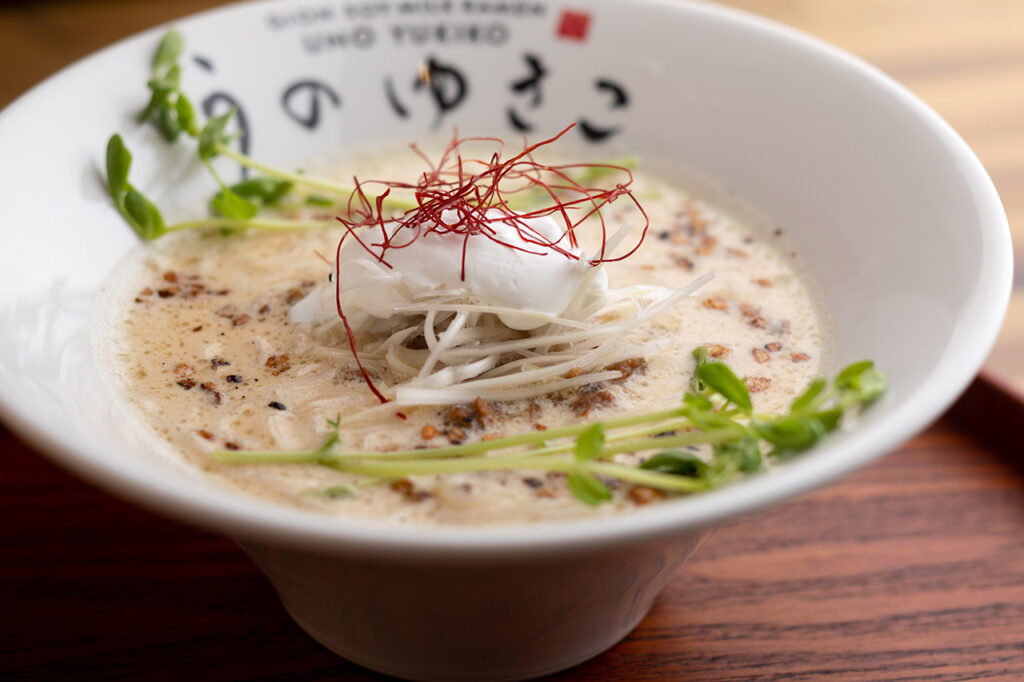
Soy Milk Ramen "Snow" is available for lunch only on weekdays from 11:00 to 14:00, and is priced at 1500 yen. The soup is based on mushroom and vegetable broth mixed with soy milk and gluten-free soy sauce. The original noodles made from rice flour and kelp have a smooth texture.

Mr. Yasuda started the restaurant in a machiya townhouse where his great-uncle ran a restaurant. In the shop where the taste of Kyomachiya has been carefully preserved, you can enjoy a seasonal vegetable bamboo steamer rice set with three layers of rice, seasonal vegetables, and meat. Meat and vegetables can be freely tasted with 7 kinds of condiments.

Steamed rice with seasonal vegetables is 2,750 yen. A healthy lunch set with [Vegesara-sha] vegetables and domestic brand pork slowly steamed in a bamboo steamer. Comes with 7 types of condiments, including Yuzu Koji Miso from [Round Table]

The signature dish, Kyoto cold noodles, made with Kyoto buckwheat flour and made to order, features smooth, firm, fresh noodles that are a perfect match with the golden soup that contains the delicious flavor of beef and vegetables. The lunch-only set menus are hearty and satisfying. The bibim noodles can be changed to bibim noodles for +100 yen. Upgrade to "Kyoku" for +300 yen, where the frozen broth is scraped off and poured over the noodles to create an exquisite harmony between the flavor of the wagyu beef broth and the acidity of sliced sudachi (a type of citrus fruit produced in Tokushima Prefecture).
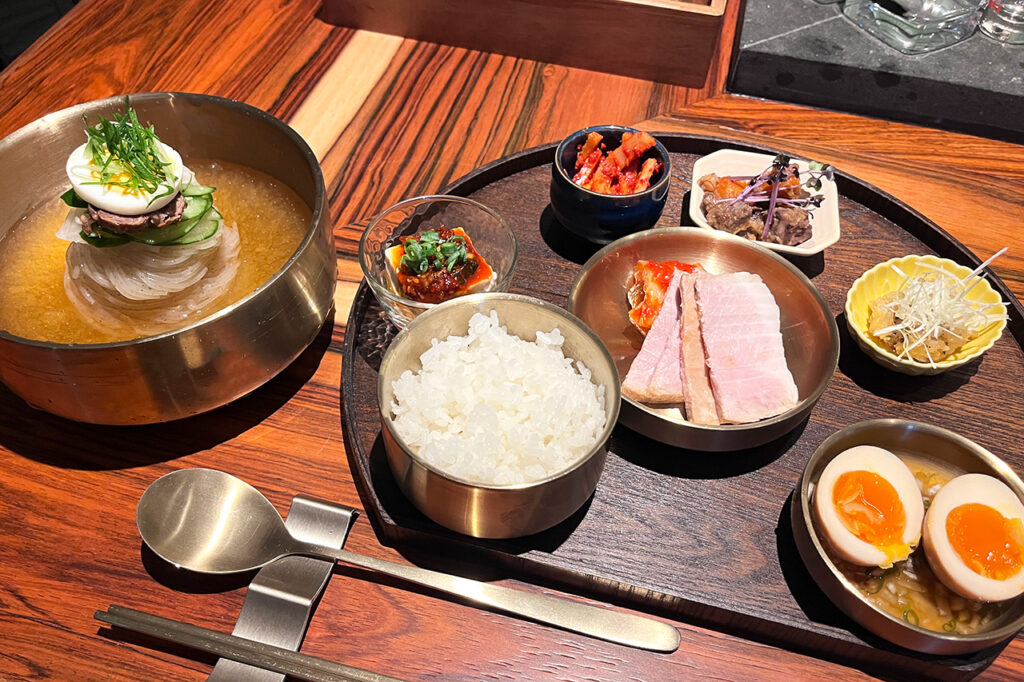
Lunch-only Kyoto Cold Noodle Gozen for 2,500 yen. Includes cold noodle, today's panchan (side dish), 4 small potted dishes of the day, rice, and dessert.

The ramen restaurant [Menkitori Baijori] is located in the back of a building on the north side of Gion, a hideaway. With a counter seating eight, you can enjoy ramen in a relaxed kappo-like space. On the menu, there are four kinds of ramen: two with chicken broth, which is also the name of the restaurant, and two with shellfish broth. Despite its appearance, the clear soup has a good punch with homemade chicken oil and garlic, while being elegant, and most customers finish the whole bowl before they know it.
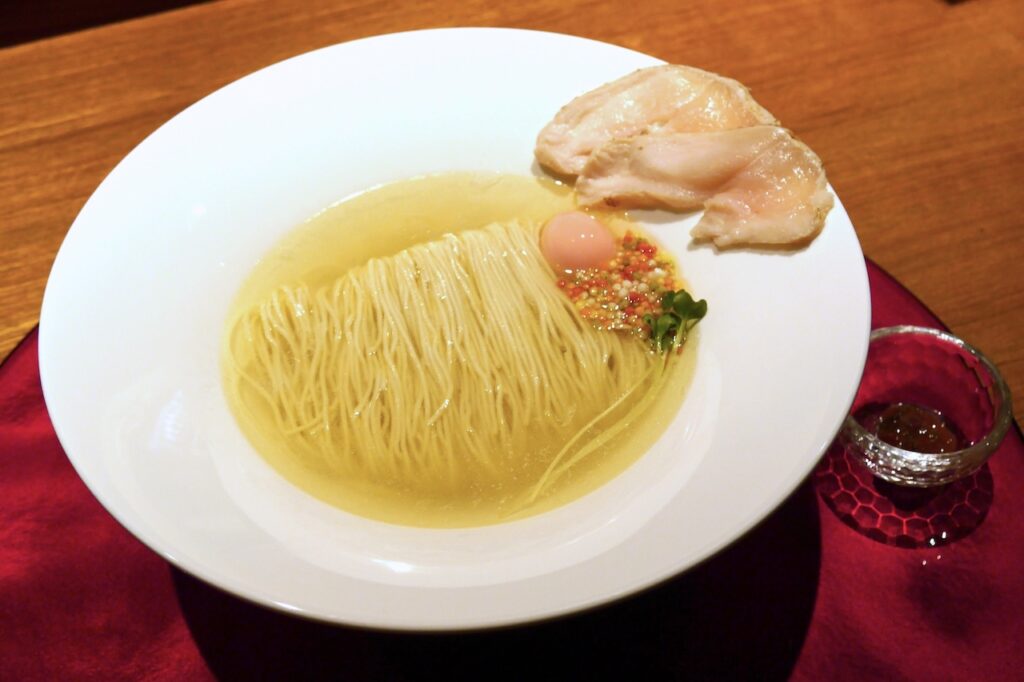
Chicken and salt plain soba noodles for 1,380 yen. The noodles are thin and straight, made by an udon specialty restaurant

A sister restaurant of NewBabe, a popular pork cutlet specialty restaurant in Osaka. You can enjoy rare brand-name pork such as Hayashi SPF pork from Chiba Prefecture, Tokyo X, Iwanaka pork from Iwate Prefecture, and Tansetsu pork from Gunma Prefecture, all cooked in a special way. The pork is deep-fried slowly at a low temperature and allowed to rest for the same amount of time as it is deep-fried to ensure that it is thoroughly cooked through and the deliciousness of the meat is locked in.

Hayashi SPF Pork Loin 150g, 2,200 yen. The fine texture of the meat and the balance of the fat are excellent, and the flavor of the meat fills your mouth when you bite into it.

The most popular ramen, Tai Dashi Ramen, uses whole sea bream from Uwajima, Ehime Prefecture. The soup is characterized by its rich and deep flavor, which is extracted by simmering the head and the bones of the sea bream at a low temperature for six hours. The noodles, which have the texture of soba (buckwheat noodles), do not disturb the flavor of the sea bream and are a perfect match for the soup.

Tai dashi soup ramen: 2,080 yen. Toppings such as seared kombu-shime snapper and low-temperature cooked chicken meat are served separately. The taste is not muddled and you can enjoy the best of the soup and ingredients.

This restaurant specializes in duck hitsu-mabushi, and opened as a sister restaurant of Gion Duck Noodles, which offers duck ramen. The rice is filled with tender duck loin cooked at low temperature and topped with three kinds of spices. We recommend the special version topped with salmon roe and sea urchin for a gorgeous appearance.
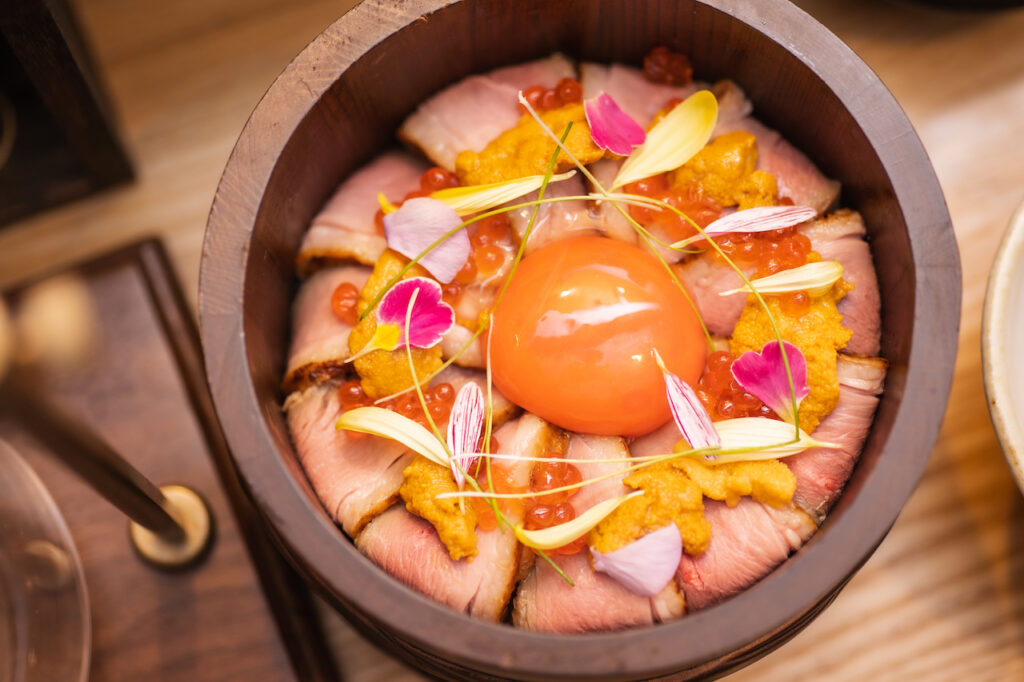
Gozen with duck hitsu-mabushi, using carefully selected duck, topped with sea urchin & salmon roe, 3,135 yen

The Gion branch of Yamakishi, where each affiliate has its own unique character, offers a sumptuous lunch that includes appetizers, boxed sushi, udon, and dessert. Among the udon dishes available from several menus, one that should not be missed is the Kujo Negi and Kitsune Udon (1,800 yen), which is made with a simple broth. In the fall, be sure to try the Matsutake mushroom udon for 5,000 yen, with its fragrant aroma of matsutake mushrooms.

Autumn limited set of fragrant Matsutake mushroom udon noodles for 5,000 yen (price is subject to change due to market value). Box sushi can be changed to chirashi sushi for +1500 yen.

[Matayoshi is a sister restaurant of Gion Matayoshi, located a 3-minute walk from Kenninji Temple, where you can enjoy Japanese food in a casual atmosphere. The ochazuke set meal is available at lunch time. Ochazuke, which has the image of a casual meal, is a high quality dish that is sure to surprise visitors with its taste and content when prepared by a chef from a ryotei (Japanese-style restaurant).

Ochazuke set meal for 3,500 yen. A variety of dishes including kobachi (small bowls of cooked food), takikomise, chawanmushi (steamed egg custard), and sashimi. Leave half of the sashimi for the final ochazuke.

Steak House Hanamoto was opened in Gion by Chef Hanamoto, who has been attracting famous guests from Japan and abroad for 25 years in Ginza, Tokyo. The lunch special steak donburi is made from Japanese black beef and priced at an unbeatable 1,500 yen. The tender red meat is grilled to perfection with charred butter, and goes great with rice.

Special steak donburi for 1,500 yen. A simple three-tiered bowl of rice, onions, and steak. Comes with salad, miso soup, and ice cream. Limited quantity.


Tongue stew set meal: 3,700 yen. The stew based on Japanese soup stock has a gentle flavor and goes perfectly with white rice. The four thickly sliced pieces of tongue are very satisfying.

Using Inaniwa udon, one of the three most famous udon noodles in Japan, the restaurant offers a wide variety of menu items, from simple Inaniwa udon based on its original chawashi broth, to Tantara Inaniwa udon that combines Japanese and Chinese flavors, and Udon suki with a variety of ingredients. The restaurant has both table and counter seating to suit any occasion. The restaurant also offers a great view of the Shijo Ohashi Bridge from its windows.
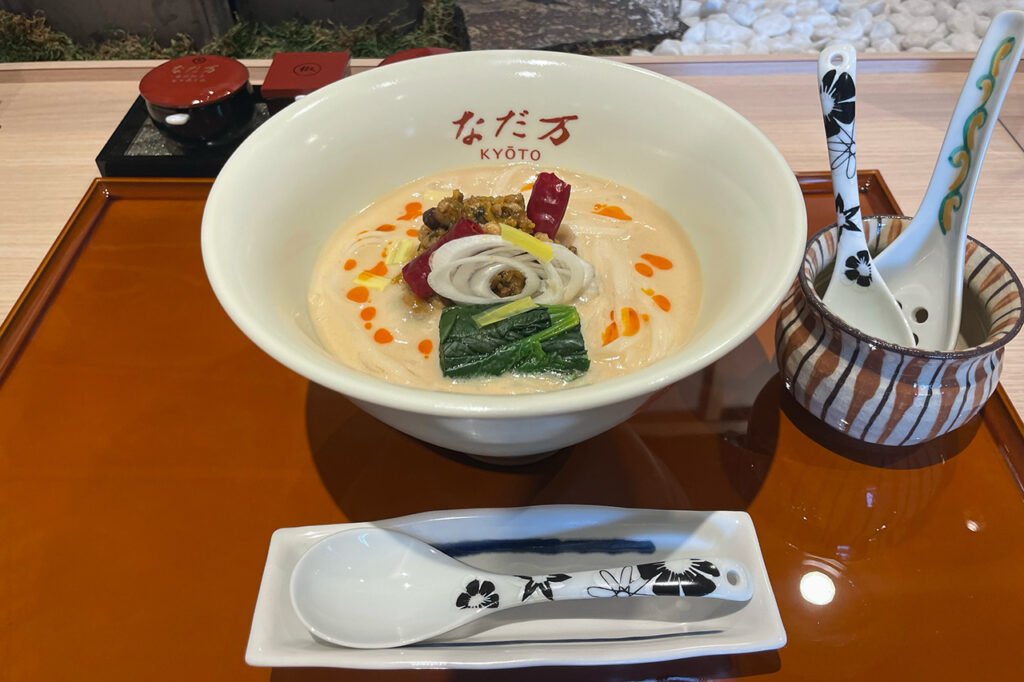
Tantanare Inaniwa Udon, a combination of original broth and Chinese richness, 1980 yen.

The ramen is served in a course style, starting with an aperitif, followed by an appetizer, ramen, and dessert. The main dish is Ramen with chicken soup and thin noodles made by Menya Hege, and 9 kinds of toppings are served separately. The chef, who has a long history of Japanese cuisine, has created unique toppings, and there are many variations to suit your tastes. Enjoy the harmony of the elegant soup and slippery noodles with toppings with a twist, such as wasabi oil, Parmesan rice crackers, and burdock root sauce.

Kyo-to Noodle 3,500 yen. Based on Tanba Black Bird, the Kaeshi is a soy sauce sauce sauce blended with 4 kinds of soy sauce and 50 kinds of salt. Enjoy changing the toppings with each bite. There is also a curry-based course, Kyo-To-Men.

A long-established Western-style restaurant established in 1915. The restaurant is credited with having developed the world-famous teriyaki sauce, and has made a brilliant contribution to the establishment of Western food culture in Japan. The hamburger steak, a staple of Western cuisine, is served with a secret demi-glace sauce that takes a week to prepare, allowing you to fully enjoy the taste of Japanese-style Western cuisine that has been handed down for 100 years.
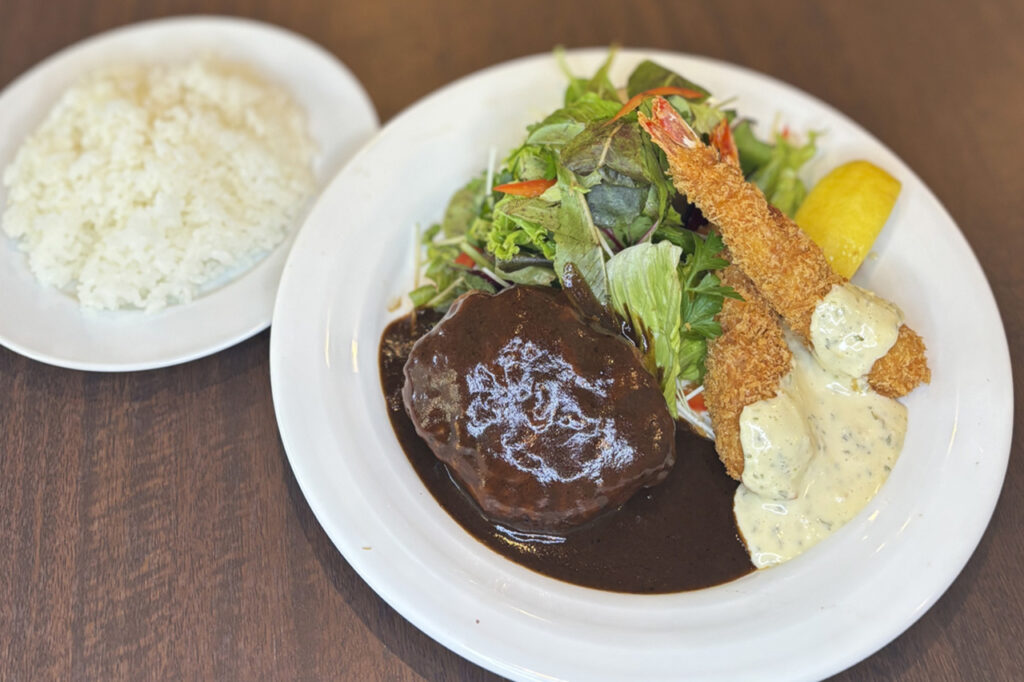
Weekday lunch menu, hamburger combo plate for 1980 yen. Includes a hamburger steak and your choice of another dish of fried shrimp, beef croquette, pork ginger, or butter-roasted salmon, and rice!

Over 600 interviews per year! An order site carefully selected by the editors who knows Kyoto and Shiga.
nowOfficial LINE friend registration500 yen OFF coupon is being issued!
Distributed every Friday morning at 8:00 am! From new restaurant information to event information that we want to share with you, We deliver articles about Kyoto that are useful to know. About 20,000 people have registered.Click here to add a friend!
 News
News Feature article
Feature article Featured event
Featured event